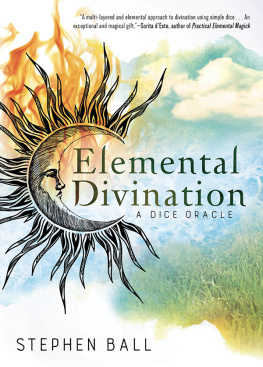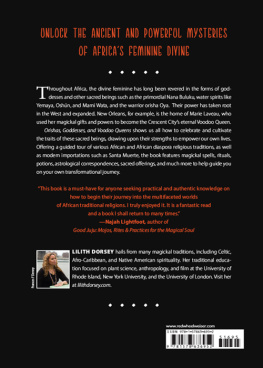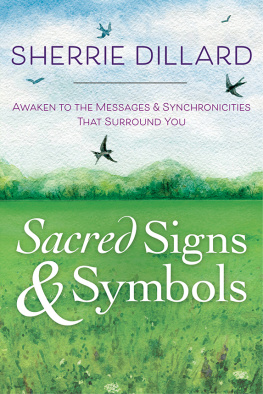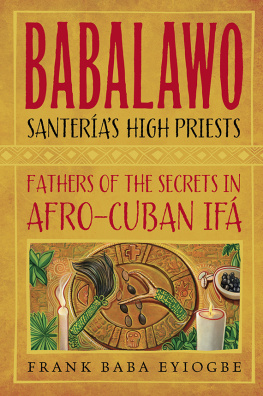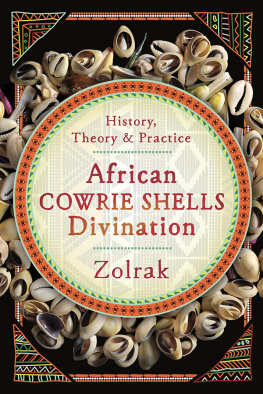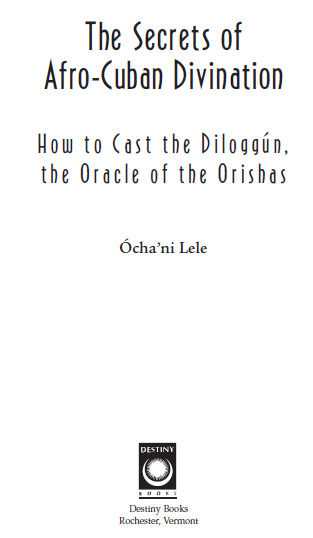
For my mother, Patricia J. Myers, who gave me life; and for the extended spiritual family that gave me life again: John Pilato, Naomi Alejandro, and Christine Jaffe. I love you all!
Nsala Malecum/Bendicin!
Acknowledgments
As an author, I am indebted to the many people who have encouraged and supported my work. I would like to begin by thanking my former publisher, Llewellyn Publications, who produced my first book, titled Between the Worlds: Witchcraft and the Tree of Life. While the subject matter of that volume is vastly different from the material contained here, the publication of my first work gave me both the spiritual courage and the financial freedom to continue my studies, research, and participation in the AfroCuban faith known as Santera.
As an adherent of Santera, I am indebted to those who gave me my foundation in the religion, setting me on the path that led to the completion of my research: Auria Gonzalez, Rigoberto Rodriguez, and Juan Gonzalez, gentle tutors who taught me the basic, oral meanings of the parent odu and their special rituals. To my many sponsors and godparents in this religion, I am always in your debt: my first godmother, Baba Lade, my first yubonna, Odofemi, and my exand onetime oriat, Afolabi. Although I am no longer a godchild in that house, the training and teaching that I received as I was given my elekes, warriors, Olokun, Ibeyi, santo lavado (Obatal), and nganga (the cauldron of Palo Mayombe) were instrumental in this volumes research. I spent many months in Michigan questioning, observing, and learning; it was through participation in that il ocha that I learned the manipulations of ob and the diloggn, the oracles of the orishas.
The list of those iyaws who were kind enough to share with me the contents of their own libretas, and even the names of the seasoned priests and priestesses who shared their own knowledge with me through the medium known as the Internet, is far too lengthy to include here, but special thanks go to Paul Bennet and Reynaldo Ruiz for their lively chats discussing the odu of the diloggn. Both are children of Obatal, and as is common of that orishas children, both possess intellectual powers and intuitive insights beyond most people I have met. Perhaps my greatest thanks should go to Christine Jaffe (omoOshn) and Naomi Alejandro (siete rayos, vititi congo) for their many hours of visits and discussions on various topics relating to AfroCuban religion. It was through countless nights of conversation and telephone teaching that many of the things I already knew yet missed, or did not know yet needed to find, were brought to life. They each read and reread my work as it progressed, offering their own comments and criticisms on the tome that I have produced. Finally, none of my research could have been completed had it not been for Manuel Caballero, who allowed me to read, copy, and translate the libreta (book of it) and the many notes and writings left behind by his deceased mother, a priestess of Yemay.
Finally, I would like to thank my godfather in Santera, John Pilato, who helped to flesh out most of the things that I missed in my initial research. If he has taught me nothing else, he has taught me that no matter what knowledge one has in ones head, if that knowledge is not matched by insights from the heart, all the learning in the world is to no avail. Even after ten years of study and research into AfroCuban lore, my true journey has only just begun. A godchild could not ask for a more involved, caring, or loving godfather, and I am glad that my years of searching and researching finally brought me humbly to his feet. John, you and I are family, and so it will remain until Death finally parts us. Ach! T!
I also need to thank the following people for their individual contributions to my work:
Mark Benezra, owner of Original Publications, for allowing me to quote freely from Aw FLokun Fatunmbis Aw: If and the Theology of Orisha Divination. On a more personal level, I must thank him for his time and encouragement as this volume was being written. The man is nothing short of brilliant, and he is a cherished mentor.
Marjorie Stevens and Anne Refoe, for realizing that I had talent as a writer and encouraging me to write feverishly. Teachers are the most important influence in our lives, and they can never be thanked enough. Thank you, thank you, thank you!
Laura Schlivek, my project editor at Inner Traditions, Jon Graham, my acquisitions manager at Inner Traditions, and Susannah Noel, my copy editor, for helping me tackle this immense project. Without them, this book would never have come into my readers hands.

Introduction
S ince the United States Supreme Court ruling in the case of the Church of the Lucum versus the city of Hialeah, Florida (June 11, 1993), Santera has ceased being an underground relic hidden for fear of persecution. Adherents are now free to practice their beliefs unhindered by social or political mores; and as information about these religious practices floods the media, many people are realizing that this nature-based faith is a joyous expression of God, the divine. While firmly grounded in the present, Santera is an ancient faith with roots in the fertile banks of Africas Niger River, where the Yoruba people propitiated spirits that later came to be known as the orishas.
The religion teaches us that the ultimate creative force, Oldumare (owner of the womb), divided itself into innumerable aspects, or orishas. Each orisha is a living, spiritual personification of limited ach (a word that loosely translates into power, grace, and life). The ach of an orisha depends on the aspect of Oldumare from which it was spawned. Olokun, the hermaphroditic deity ruling the depths of the ocean, draws her ach from the part of Oldumare that is secret, mysterious, and unknown; hence her home is the depths of the ocean where none may descend while living in the flesh. Ain, mistress of flame and constant companion to Shang, is the limitless fire of Oldumares existence; and Yemay is the sweet, life-giving, mothering principle of the unknowable deity. Too vast to be known as a whole, Oldumare is made knowable through the religions myriad deities.
An orisha, as received by an initiate of this faith, has three components: implements (handcrafted tools), otanes (sacred stones), and diloggn (cut cowrie shells used for ritual divination). The diloggn houses the soul of the orisha and is the most important component. When commercial slavery removed blacks from the Mother Continent by the thousands, the Africans took these holy shells, the diloggn, into their bodies and made the Middle Passage to the New World. Priests and priestesses secreted the shells in one of three places: the hair, vagina, or digestive tract. Those who hid their shells in either the hair or vagina were less successful in bringing their deities to the New World. Those who swallowed their shells (repeatedly, for obvious reasons) were able to hide theirs from captors. This is one of many illustrations of the unshakable faith the Africans held in their gods. Those who survived and settled under Catholic slavery were able to worship the orishas in secret, especially in the tropical climates of the Caribbean. (Cuba and Brazil provided the most hospitable locales for orisha worship.) There is some archaeological evidence that both the orisha faiths and Palo Mayombe, the Congolese cult of the dead, were brought to the mainland (what is now the United States) at this time. However, slavery under Protestant rule separated the family and social units, which prevented worshipers from keeping the faith alive. But because Catholic slavery kept family and social groupings intact, slaves in both the Caribbean and Brazil were able to pass along their faith to their children. Against inhumane, harsh treatment, the African gods sustained their people.
Next page

